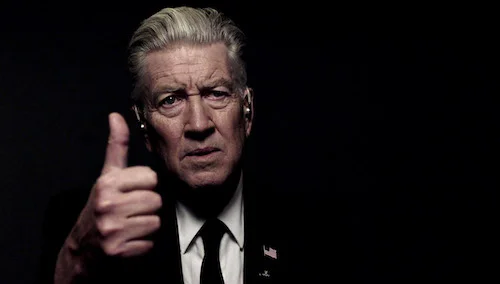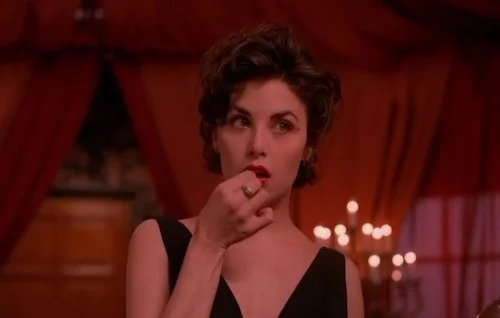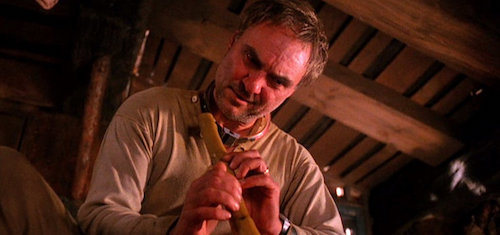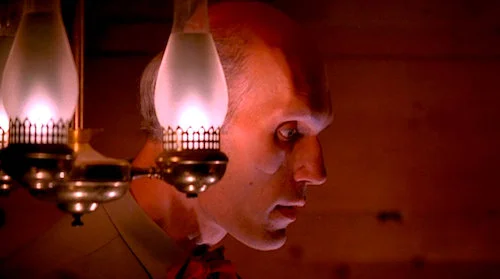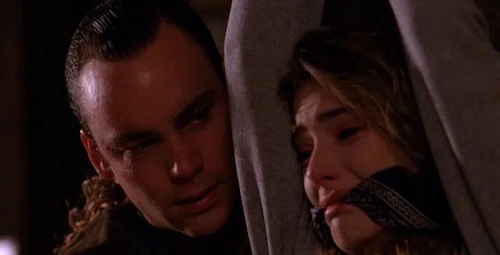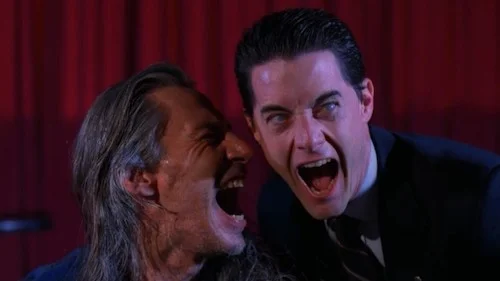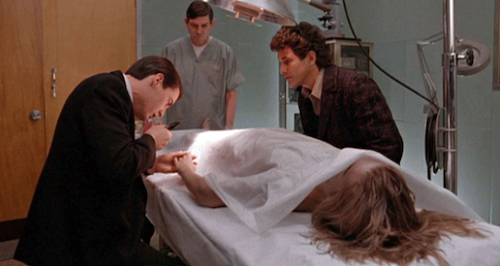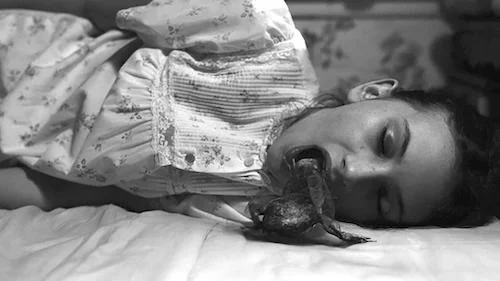Twin Peaks Week: The Top Ten Episodes
The Top Ten Episodes
After discussing the entire series and its many iterations ad nauseam, I think it’s time to really get down to brass tacks and discuss why this week even happened. Twin Peaks is a cultural phenomenon, which continues to sprawl into society and our cerebellums. Despite the lack of professionalism, this wouldn’t be a slice of the cherry pie of television history without some gushing, right? There has been analysis-upon-analysis in my season-specific articles of the show: the inquiries of David Lynch’s obsession with parallelisms. This list won’t dig too deeply into those kinds of thoughts. Instead, this is a personal think piece on what the ten greatest episodes of the series are, as a send off to this glorious week (and maybe the show as a whole; who knows if it will ever come back again).
Let’s commemorate Twin Peaks for potentially the last time.
10. Realization Time (Season 1, Episode 7)
“What I want and what I need are two different things, Audrey.”
-Special Agent Dale Cooper
This is the ultimate turning point for Audrey Horne. We realize she is a misguided teenager when she tries to swoon Special Agent Dale Cooper. Like the gentleman that he is, he explains the inappropriateness of her behaviour without completely humiliating her. That’s why her investigation of One Eyed Jacks becomes terrifying. We no longer get infuriated by her by any stretch. The tables quickly turn with Audrey and her family’s varying dynamics in this episode.
There’s also the cooky myna bird being used as a witness (sure, why not), whose desperate cries end up being terrifying. It’s Leo Johnson at it again! He killed a poor bird, for crying out loud! Shelley is seemingly out of his grasp, but we know it isn’t for long. Donna, James and Madeline find their way towards Dr. Jacoby’s office in search of Laura’s killer. On a first watch, you aren’t sure who murdered Laura Palmer, but you begin to suspect a number of people. On a rewatch, this episode becomes a harbinger for so many characters you’ve spent the last few hours with. Things get frightening for all of them, and anxious for us.
9. Slaves and Masters (Season 2, Episode 15)
“Our sheriff’s got a problem with his girlfriend…”
-Albert Rosenfield
It’s hard to pick the best Windom Earle episode, because I truly believe everyone will have a different answer. This one — for me — seemed to put a fire under the second half of season two in such a swift way. Bobby and Shelley are starting to worry about Leo Johnson again, and they confess to Agent Cooper. Albert Rosenfield has been sent (with strict orders from Gordon Cole) to protect him from Earle. Earle, oddly enough, conveniently ends up at Leo’s, and he tortures him worse than one could imagine at this present time (it’s twisted, anyways).
Then we have the continuation of Josie Packard’s scandal, Dr. Jacoby’s cursed mindset, and the love between Ed Hurley and Norma Jennings (almost) blossoming. There’s chess as a heavy theme here, and the entire episode indeed feels like an ongoing game that nicely sets up the rest of the season with the first moves. Believe it or not, famed performer Diane Keaton (yes, Annie Hall Diane Keaton) directed this episode, and was able to provide season 2 with some much needed spunk.
8. Call For Help (Season 3, Episode 3)
“If it's not here, then how do you know it's missing?”
-Deputy Hawk
When The Return first came out, parts one and two were a combined televised event. It was then revealed that parts three and four were going to be available online. We absolutely had to see what was going to happen after the arm’s new form (well, the tulpa anyways) banished Agent Cooper into oblivion. Part three starts off with Cooper falling through space, and it only gets weirder. With the most experimental edits, effects, and imagery in Twin Peaks (for now), we knew this series was going to go bonkers. There’s (Evil Cooper) Mr. C’s brush with death (and garmonbozia to boot); his grip on hanging on to real life is truly felt in these moments.
What makes this episode even better is Cooper’s embodiment of Dougie Jones’ former self. Cooper is now braindead, and hinged on reactions and mimicry (like a parrot combined with an insect). He gets lost in the casino, and is led by special forces to winning many jackpots. This moment is beyond hilarious, as his very loose grasp of reality is ours, too. We learn that this return to Twin Peaks (through space, or even through a bloody casino) may be a bit more difficult than we thought.
7. May the Giant Be With You (Season 2, Episode 1)
“The owls are not what they seem.”
-Giant
We start season two wondering why the hell that stranger won’t help Dale Cooper, who is clearly stuck on the ground after having been shot. Luckily, Cooper is okay. He was only having a meeting with the Giant (who may or may not be the “Fireman” in The Return). The Giant is clearly of the White Lodge, and has sensed Cooper’s ability to access the Black Lodge. He lists off a handful of clues for Cooper in his own cryptic way. These are clues for us, too. We have to pay attention to every owl from here on out, especially since we discover that Bob operates through them.
Leland has come back a new man (ghost white hair and all). James Hurley is wrongfully placed behind bars. Donna decides to follow in Laura’s footsteps and take part in the Meals on Wheels program. Leo and Nadine are both comatose for different reasons, and they survive their states in very contrastive ways. This is a new season, and we are finding many memorable faces in different predicaments. What exactly happened when Cooper woke up? Is this the same Twin Peaks he collapsed in? Who knows, once we see how the rest of the show unfolds.
6. The Last Evening (Season 1, Episode 8)
“Be quiet. I’m thinking.”
-Catherine Martell
You will find the reoccurring theme that Twin Peaks knew how to start and end seasons extremely well. Case in point, we have this explosive finale from season one. The Packard Mill is up in flames, and Shelley Johnson is caught in the middle of it after being tied up there by her abusive husband Leo. Leo is out looking for other people to murder, particularly Bobby Briggs. Catherine Martell proves her incredible ability to scheme on the spot by saving Shelley and thinking of a way to get the most out of this freak scenario for herself. She’s almost too much of a genius.
All hell is breaking loose at the Canadian border, as the Renault deal goes bust, and Jacques Renault gets pinned for his connection to Laura Palmer’s extremely complicated death. Her killer wasn’t found, but at least one of the many demons of her life was caught. Then there’s Leland vowing for vengeance, as he pays a visit to the local hospital to try and do away with Laura’s killer for good, only to murder Renault while he was recovering from the sting. Dr. Jacoby is left unconscious, too, thanks to the scheme of the three teenagers trying to find their own “killer”. Season one ends with mercy attacks from the “innocent”, and hate killings by the evil. It’s so very sick.
5. Beyond Life and Death (Season 2, Episode 22)
“He can't ask for your soul. I will take his.”
-Bob
If we’re looking at Twin Peaks finales, we have to include the best of the bunch: season two’s. If Season two was a slog for you, there were four words in the credits that made you rethink your marathoning ways: “Directed by David Lynch”. This finale was done by the eccentric himself. The show at that point was canceled, and this was going to be its unfortunate send off. Yet, we couldn’t have had it any better. Agent Cooper gets lost amidst the Black Lodge and finds Windom Earle (his latest enemy) at the clutches of Bob. Season two ends way stranger than the entire series had been up until this point. It might be tame after Fire Walk With Me or The Return, but it’s still a nightmare.
We wrap things up with Bob inside of Cooper’s body in Twin Peaks. We see Cooper and a clone sprinting around the Black Lodge, only to know that the real copy is doomed to stay there forever. Was it for Annie, or was it for Laura? After the dream back in episode two of season one, it seemed like fate that Cooper would wind up here. Now that we’ve arrived, it’s not exactly how any of us planned it would be. Evil Cooper smashes his head into a mirror and laughs his face off, as blood smears down his mug. If the show were to continue, where would it go from here? If it remained like this, why does the town have to suffer? People were left wondering for over two decades, with nothing but a crimson Cooper to remember.
4. Arbitrary Law (Season 2, Episode 9)
“I have this thing for knives. Just like what happened to you that time in Pittsburgh, Cooper.”
-Leland Palmer
We’ve known who Laura Palmer’s human killer is at this point: her own father Leland. We’ve seen him strike again with her near-identical cousin Madeline. Now, Leland is in hot water. This isn’t like Laura’s death, where the town was completely unaware that anything like this could happen. Eyes were everywhere. Cops were present. This was a bad move, but Bob got Leland to kill again. This episode is the chase to finally end this hunt for good.
This is what ABC wanted. They wanted Laura’s murderer to be revealed. Knowing her father brutally raped and killed her is just sick, and perhaps the most striking person that could have been selected out of the entire town. It still doesn’t completely solve everything, as Bob is the real threat; who would know that outside of a few rare exceptions, though? Leland battles between his real state and Bob’s control, and his fight is devastating to witness. This is a father who is finally opening up about the awful crimes he has committed, with great regrets and guilts. This is also Bob being unhappy with his vessel, who is now ruining his plans. This is complete self destruction, and devastation is rarely captured this viciously.
3. The Past Dictates the Future (Season 3, Episode 17)
“I’ve seen you in a dream.”
-Laura Palmer
While the actual finale for The Return was also great (one last head spinning series of events to truly leave you out in a fog), the part before was the actual conclusion to Twin Peaks (part eighteen was an epilogue of sorts). Here, we see Bob being killed once and for all (through Freddie and his season-long quest to use his super strong fist). The faceless woman shifts into the real Diane (and not the foul mouthed tulpa we sat alongside the rest of the season). Cooper finally has cracked the case of who Laura’s killer is (with the world to witness it, anyways). Suddenly, Cooper’s face is planted on top of everything. Are our television sets bugging out? What is this? “We live inside a dream”, the face suddenly says. No. Why is this here? It lingers, like our senses of doubt. Something isn’t quite right.
But we only figure that out for good in part eighteen. For now, we see Cooper travel back to the day of Laura Palmer’s murder as an effort to save her. The combining of old footage and new shots is near seamless. We can tell when the original takes were done, but once Laura walks towards us and starts talking to a clearly-modern Cooper, the magic truly begins. The moment when Laura grabs Coopers hand, he declares “We’re going home”, and Angelo Badalamenti’s iconic theme play has to send any Twin Peaks fan into a state of tears. Then, we remember: there is still an entire hour after this. Laura vanishes, and we gulp. It couldn’t have been that easy, right?
2. Northwest Passage (Season 1, Episode 1)
“She’s dead. Wrapped in plastic.”
-Pete Martell
We absolutely have to include the greatest television pilot of all time. From the very first seconds, of Josie Packard doing her make up in the mirror and looking behind her, to Pete Martell going fishing under ominous synths, we knew this was going to be one aesthetically brilliant ride. Martell stumbles upon the body of Laura Palmer, who resembles a decaying bouquet of flowers lingering on the shore of the lake. The entire town goes into a standstill. Witnessing everyone’s reactions says enough. We don’t know much about Laura, but we are figuring out her impact on the entire community. It all hurts so damn much. We barely know this show, and everything is soul crushing.
We then see the police procedural elements come into play. Agent Cooper is sent on assignment to Twin Peaks, and we get familiar with the local department before these worlds converge. Aside from these plot elements, the pilot is catalyzed by art. The slow zooms. The deep colours. The sharp angles. The extreme close ups. This is not television as we know it. This is one step beyond. Many shows to this day are trying to capture the feel of this show (and this pilot, specifically). Who knows if it can be done again, despite the many attempts. Nothing was like this fine hour (and a half) of television, and it never would be again.
1. Gotta Light? (Season 3, Episode 8)
“This is the water, and this is the well. Drink full, and descend. The horse is the white of the eyes, and the dark within.”
-Woodsman
If the pilot was OK Computer, part eight of season three is Kid A. Never has a single second (let alone an entire freaking hour) of television been so experimental. We get the trivialities out of the way: an assassination attempt on Mr. C (Evil Cooper) is committed, only for Mr. C to be built back together by the “woodsmen”. We get our Roadhouse performance of the episode very early (“The” Nine Inch Nails). Is that the end of the episode? Perhaps. It’s the entire Twin Peaks: The Return episode as we know it.
Now, for the rest of the duration, we dive straight into a new dimension. A nuclear bomb goes off, linking Bob’s existence with the hatred and technological advancements of humanity. The White Lodge is restless. A saving grace is concocted for the world to take care of: Laura Palmer. This is bittersweet, because we know that doesn’t go well. We then see Sarah Palmer in the ‘50s: a young girl with her entire life ahead of her. She is possessed in her sleep by a foreign, sinister creature (after being lulled by a woodsman’s chant on the radio). Her life is to forever be cursed, and she doesn’t even know it yet. The heartbreak attached to this final shot (and its hypnotically conjured photography) makes for arguably the greatest image in all of Twin Peaks (and that is saying a lot).
This is a loose narrative that glosses over all of the actual magnificence of the episode, though. Avant garde images. Jarring editing. Complete sound manipulation. This is an entire new world. There is a chance we will never see this on a T.V. set ever again in our lifetimes. The lack of dialogue for a majority of the episode. The lengthy science shots. The haunting music connected to a world we’ve never quite gotten familiar with before. The brutality of the woodsmen slaughtering innocent bystanders. Everything smacks together like consecutive punches to the gut. You continuously are baffled at what you are seeing, and this doesn’t quite continue as much as it refreshes every ten minutes. This exists. This existed on television. People sat in their homes and watched this. It’s been two years, and I’m still stunned that David Lynch and Mark Frost got away with this episode. It is pure art of the highest form, and it is sure to go down as one of the most singular experiences in television history.
Andreas Babiolakis has a Masters degree in Film and Photography Preservation and Collections management from Ryerson University, as well as a Bachelors degree in Cinema Studies from York University. His favourite times of year are the Criterion Collection flash sales and the annual Toronto International Film Festival.


